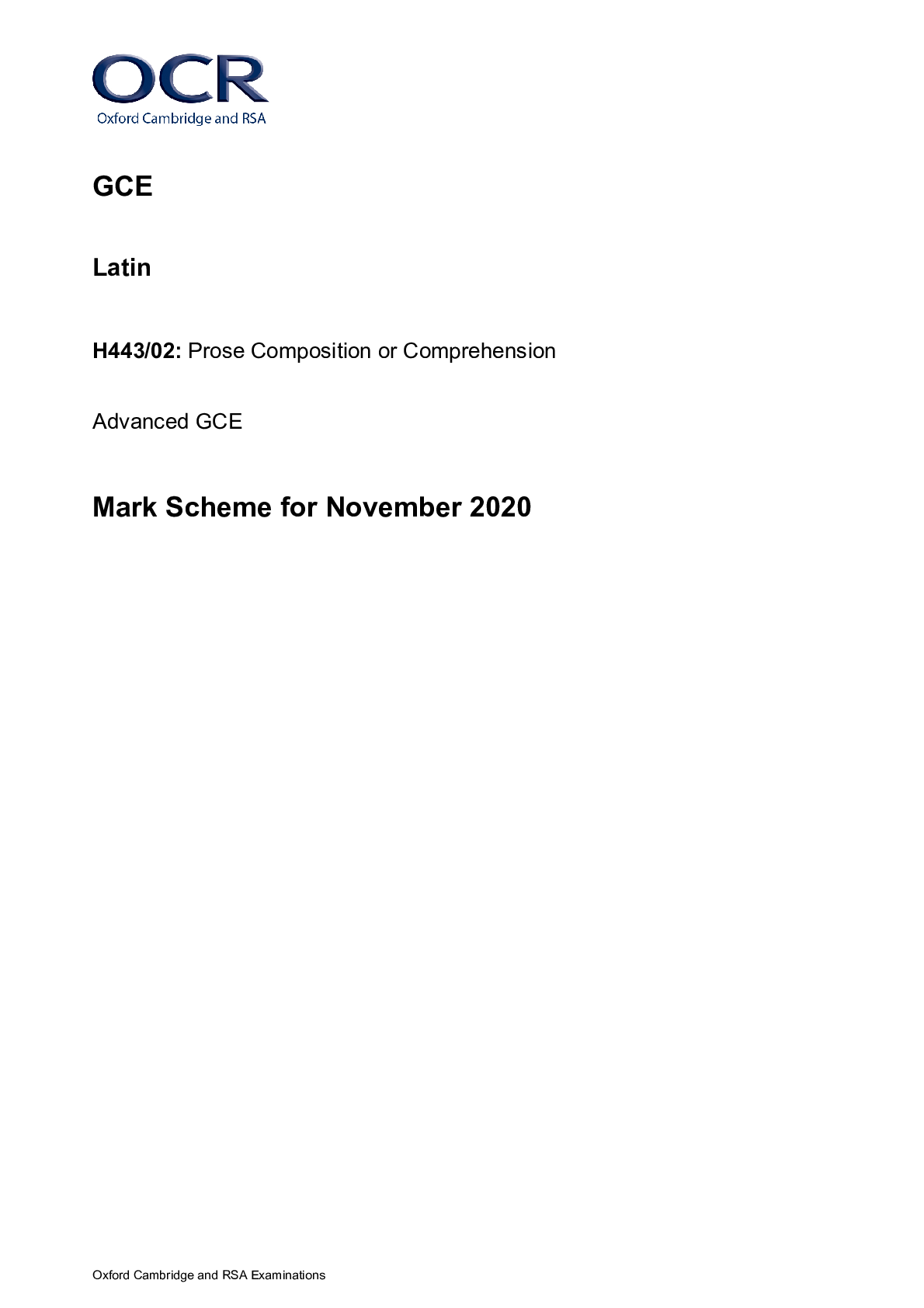History > GCSE MARK SCHEME > GCSE (9–1) History B (Schools History Project) J411/21: History Around Us General Certificate of S (All)
GCSE (9–1) History B (Schools History Project) J411/21: History Around Us General Certificate of Secondary Education Mark Scheme for November 2020
Document Content and Description Below
GCSE (9–1) History B (Schools History Project) J411/21: History Around Us General Certificate of Secondary Education Mark Scheme for November 2020 Oxford Cambridge and RSA Examinations GCS... E (9–1) History B (Schools History Project) J411/21: History Around Us General Certificate of Secondary Education Mark Scheme for November 2020Oxford Cambridge and RSA Examinations OCR (Oxford Cambridge and RSA) is a leading UK awarding body, providing a wide range of qualifications to meet the needs of candidates of all ages and abilities. OCR qualifications include AS/A Levels, Diplomas, GCSEs, Cambridge Nationals, Cambridge Technicals, Functional Skills, Key Skills, Entry Level qualifications, NVQs and vocational qualifications in areas such as IT, business, languages, teaching/training, administration and secretarial skills. It is also responsible for developing new specifications to meet national requirements and the needs of students and teachers. OCR is a not-for-profit organisation; any surplus made is invested back into the establishment to help towards the development of qualifications and support, which keep pace with the changing needs of today’s society. This mark scheme is published as an aid to teachers and students, to indicate the requirements of the examination. It shows the basis on which marks were awarded by examiners. It does not indicate the details of the discussions which took place at an examiners’ meeting before marking commenced. All examiners are instructed that alternative correct answers and unexpected approaches in candidates’ scripts must be given marks that fairly reflect the relevant knowledge and skills demonstrated. Mark schemes should be read in conjunction with the published question papers and the report on the examination. © OCR 2020J411/21 Mark Scheme November 2020 2 Annotations Annotation Meaning Level 1 Level 2 Level 3 Level 4 Level 5 Noted but no credit given Not answered question Extendable horizontal wavy lineJ411/21 Mark Scheme November 2020 Subject–specific Marking Instructions INTRODUCTION Your first task as an Examiner is to become thoroughly familiar with the material on which the examination depends. This material includes: • the specification, especially the assessment objectives • the question paper and its rubrics • the mark scheme. You should ensure that you have copies of these materials. Please ask for help or guidance whenever you need it. Your first point of contact is your Team Leader. INFORMATION AND INSTRUCTIONS FOR EXAMINERS 1 The practice and standardisation scripts provide you with examples of the standard of each band. The marks awarded for these scripts will have been agreed by the PE and Senior Examiners. 2 The specific task–related indicative content for each question will help you to understand how the band descriptors may be applied. However, this indicative content does not constitute the mark scheme: it is material that candidates might use, grouped according to each assessment objective tested by the question. It is hoped that candidates will respond to questions in a variety of ways. Rigid demands for ‘what must be a good answer’ would lead to a distorted assessment. 3 Candidates’ answers must be relevant to the question. Beware of seemingly prepared answers that do not show the candidate’s thought and which have not been adapted to the thrust of the question. Beware also of answers where candidates attempt to reproduce interpretations and concepts that they have been taught but have only partially understood. 4 You are reminded that you have access to information about the chosen site submitted by each candidate’s centre, and that you must refer to this if you are in any doubt about details included in the candidate’s answers.J411/21 Mark Scheme November 2020 4 Awarding Spelling, Punctuation and Grammar to scripts with a scribe coversheet a. If a script has a scribe cover sheet it is vital to check which boxes are ticked and award as per the instructions and grid below: i. Assess the work for SPaG in accordance with the normal marking criteria. The initial assessment must be made as if the candidate had not used a scribe (or word processor) and was eligible for all the SPaG marks. ii. Check the cover sheet to see what has been dictated (or what facilities were disabled on the word processor) and therefore what proportion of marks is available to the candidate. iii. Convert the SPaG mark to reflect the correct proportion using the conversion table given below. SPaG mark awarded Mark if candidate eligible for one third (e.g. grammar only) Mark if candidate eligible for two thirds (e.g. grammar and punctuation only) 0 0 0 1 0 1 2 1 1 3 1 2 4 1 3 5 2 3 b. If a script has a word processor cover sheet attached to it the candidate can still access SPaG marks (see point a. above) unless the cover sheet states that the checking functionality is enabled, in which case no SPaG marks are available. c. If a script has a word processor cover sheet AND a scribe cover sheet attached to it, see point a. above. d. If you come across a typewritten script without a cover sheet please check with the OCR Special Requirements Team at [email protected] who can check what access arrangements were agreed. e. If the script has a transcript, Oral Language Modifier, Sign Language Interpreter or a Practical Assistant cover sheet, award SPaG as normal.J411/21 Mark Scheme November 2020 Question 1–20 marks ( ) Why did people first start using your site? Use physical features of the site as well as your knowledge to support your answer. Levels AO1 Demonstrate knowledge and understanding of the key features and characteristics of the periods studied. Maximum 5 marks AO2 Explain and analyse historical events and periods studied using second-order historical concepts. Maximum 5 marks AO3 Analyse, evaluate and use sources (contemporary to the period) to make substantiated judgements, in the context of historical events studied. Maximum 10 marks Notes and guidance specific to the question set Level 5 (17–20 marks) Demonstrates strong knowledge of key features and characteristics of the past of the site and/or its historical context in ways that show secure understanding of them(AO1) These are used to support a sustained, consistently focused and convincing explanation that shows a sophisticated understanding of second order concepts appropriate to the question (AO2) Analyses in detail a range of specific and appropriate features of the site and evaluates these thoroughly to reach a consistent, plausible, and very well-substantiated answer to the specific question (AO3). The question focuses on criteria b and a. The response should focus on assessing specific features of the site and how they reveal reasons for the first use of the site. If the site has more than one iteration, the chosen iteration should be made clear (for example, a government-controlled site that was once in private hands). In addressing the question, responses are likely to consider geographical factors – for example the locating of a castle on a hill, near a river or existing settlement, for reasons of strategy or supply of food or materials. A specific example might be the siting of Kenilworth castle to monitor the nearby Earl of Warwick. Answers may instead choose to focus on the specific motivations of those involved in using the site – for example the motivation to win wars or survive potential nuclear attacks led to the creation of sites from castles to nuclear bunkers; monks or monastic orders looking for secluded areas. Individual motivations may also feature, even explaining by comparison to other similar sites e.g. how the keep at Colchester Castle, like the Tower in London and Chepstow Keep, is situated over Roman ruins, illustrating William’s desire to be associated with the imperial past. Responses may also draw on aspects of other criteria Level 4 (13–16 marks) Demonstrates sound knowledge of key features and characteristics of the past of the site and/or its historical context in ways that show secure understanding of them (AO1) These are used to support a sustained and generally convincing explanation that shows a strong understanding of second order concepts appropriate to the question (AO2). Analyses a range of specific and appropriate features of the site and evaluates these to reach a consistent, plausible, and well-substantiated answer to the specific question (AO3). Level 3 (9–12 marks) Demonstrates sound knowledge of key features and characteristic of the past of the site and/or its historical context in ways that show some understanding of them (AO1); These are used to support an explanation that shows sound understanding of second order concepts appropriate to the question (AO2). Analyses a range of appropriate features of the site and evaluates these to reach a plausible and substantiated answer to the specific question (AO3). Level 2 (5–8 marks) Demonstrates some knowledge of features and characteristics of the past of the site and/or its historical context in ways that show some understanding of them (AO1); These are used to support an explanation that shows some understanding of second order concepts appropriate to the question (AO2).J411/21 Mark Scheme November 2020 6 Identifies, with some explanation, some appropriate features of the site and uses these to give a generally plausible, supported answer to the specific question (AO3). and these should be credited in line with the levels, if used appropriately to address the question. A feature of higher-level responses may be the presence of several explained reasons for the site beginning to be used, along with a judgement relating to the most important reason for its first creation. The second order historical concept here is “causation” i.e. the importance of the site either locally or nationally. A sophisticated understanding of causation will use criteria to judge the reasons for the site’s first use. For example, whether strategic or even moral reasons were more important than purely geographical ones. Responses that deal with aspects of the question separately without addressing how they relate to each other, (in this case, for example, describing the events leading to the first use of the site, perhaps its construction, without explaining the reasons for that construction) should not be awarded marks above Level 1. Level 1 (1–4 marks) Demonstrates some knowledge of features and characteristics of the past of the site and/or its historical context (AO1) This is used to attempt an explanation that shows some basic understanding of second order concept(s) appropriate to the question (AO2). Includes some features of the site and attempts, at least in general terms, to use these to answer the question (AO3). 0 marks No response or no response worthy of credit.J411/21 Mark Scheme November 2020 Question 1 – 20 marks ( ) Why did people first start using your site? Use physical features of the site as well as your knowledge to support your answer. Guidance and indicative content Level 5 (17-20 marks) Level 5 answers will typically explain three reasons for site’s first use using contextual knowledge and/or physical features eg People first started using Site X because ….. [physical features; location; available resources; strategic location; political or social or economic context ….. ] The site was suitable as a response to [identified factor] because ……….. Another factor which led people to start using the site was ….. The site was a good response to this factor because ….. Repeat Nutshell: Explanation of how three specific factors led to first use of site Level 4 (13-16 marks) Level 4 answers will typically explain two reasons for site’s first use using contextual knowledge and/or physical features eg People first started using Site X because ….. [physical features; location; available resources; strategic location; political or social or economic context ….. ] The site was suitable as a response to [identified factor] because ……….. Another factor which led people to start using the site was ….. The site was a good response to this factor because ….. Nutshell: Explanation of how two specific factors led to first use of site Level 3 (9-12 marks) Level 3 answers will typically explain one reason for site’s first use using contextual knowledge and/or physical features eg People first started using Site X because ….. [physical features; location; available resources; strategic location; political or social or economic context ….. ] The site was suitable as a response to [identified factor] because ……….. Nutshell: Explanation of how specific factor led to first use of site Level 2 (5-8 marks) Level 2 answers will typically identify but not explain reason(s) why the site was first used e.g. People first started using Site X because ….. [physical features; location; available resources; strategic location; political or social or economic context ….. ] Nutshell: Identification of reasons Level 1 (1-4 marks) Level 1 answers will typically name the date of the first use of the site OR describe the site OR its uses over time eg Site X was first used by people in DATE. OR Site X is in Location Y. It has ….. [physical features eg water, high ground …] OR People have used Site X for many different things. For example …. Nutshell: Assertion without support or development; Describes site 0 marksJ411/21 Mark Scheme November 2020 8 Question 2 – 20 marks ( ) Choose a significant turning point in your site's past. How far did this change the site, its people or its uses? Use physical features of the site as well as your knowledge to support your answer. Levels AO1 Demonstrate knowledge and understanding of the key features and characteristics of the periods studied. Maximum 5 marks AO2 Explain and analyse historical events and periods studied using second-order historical concepts. Maximum 5 marks AO3 Analyse, evaluate and use sources (contemporary to the period) to make substantiated judgements, in the context of historical events studied. Maximum 10 marks Notes and guidance specific to the question set Level 5 (17–20 marks) Demonstrates strong knowledge of key features and characteristics of the past of the site and/or its historical context in ways that show secure understanding of them(AO1) These are used to support a sustained, consistently focused and convincing explanation that shows a sophisticated understanding of second order concepts appropriate to the question (AO2) Analyses in detail a range of specific and appropriate features of the site and evaluates these thoroughly to reach a consistent, plausible, and very well-substantiated answer to the specific question (AO3). The question focuses on criteria d and g. It also allows candidates to draw on criteria c, e, f and n. The response should focus on how the chosen turningpoint marked a change in the site, its use or the people associated with it. Responses should identify specific features of the site and how they reveal the use of the site both before and after the chosen turning-point (e.g. explain how the nine altars at Fountains Abbey were used prior to the Reformation as chantries, which reflect late medieval piety, whereas afterwards they were used as a source of building material for Fountains Hall). Responses may also identify continuities (e.g. the continued use of the Mill and Granges at Fountains Abbey both before and after the Reformation). Responses may discuss reasons for these changes or compare this change with the use of the site throughout its history. When referring to the people associated with the site, candidates may draw upon their knowledge of the site but also link changes in the site’s features to the people involved in those changes; continuing with Fountains as an example, the sale of the abbey to Richard Gresham following dissolution, leading to the removal of large amounts of stone to create Fountains Hall for its owners, and the eighteenth-century changes introduced by the Aislabie family, including the water gardens at Studley Royal that made the Abbey little more than an ornament or folly. If more than one turning point is used, it must be compared or linked back to the original turning point Level 4 (13–16 marks) Demonstrates sound knowledge of key features and characteristics of the past of the site and/or its historical context in ways that show secure understanding of them (AO1) These are used to support a sustained and generally convincing explanation that shows a strong understanding of second order concepts appropriate to the question (AO2). Analyses a range of specific and appropriate features of the site and evaluates these to reach a consistent, plausible, and well-substantiated answer to the specific question (AO3). Level 3 (9–12 marks) Demonstrates sound knowledge of key features and characteristic of the past of the site and/or its historical context in ways that show some understanding of them (AO1); These are used to support an explanation that shows sound understanding of second order concepts appropriate to the question (AO2). Analyses a range of appropriate features of the site and evaluates these to reach a plausible and substantiated answer to the specific question (AO3). Level 2 (5–8 marks) Demonstrates some knowledge of features and characteristics of the past of the site and/or its historical context in ways that show some understanding of them (AO1); These are used to support an explanation that shows some understanding of second order concepts appropriate to the question (AO2). Identifies, with some explanation, some appropriate features of the site and uses these to give a generally plausible, supported answer to the specific question (AO3).J411/21 Mark Scheme November 2020 Level 1 (1–4 marks) Demonstrates some knowledge of features and characteristics of the past of the site and/or its historical context (AO1) This is used to attempt an explanation that shows some basic understanding of second order concept(s) appropriate to the question (AO2). Includes some features of the site and attempts, at least in general terms, to use these to answer the question (AO3). (here, for example, the Dissolution) in terms of the extent of change that ensured. Responses may also draw on aspects of other criteria and these should be credited in line with the levels, if used appropriately to address the question. A feature of higher level responses may be a judgement related to how far the turning-point resulted in change. The second order historical concept here is “change”. i.e. identify a specific turning-point in the site’s past and how this reveals change. A sophisticated response might explain the different pace of change and how much change happened at this particular moment in comparison to continuities; it may also identify trends in comparison to other similar sites. Answers may also consider related concepts such as “causation” and “consequence”. i.e. reasons for change in terms of people or conditions (e.g. “As a result of the reformation…” ) or “diversity” (i.e. range of activities and people associated with the site in relation to before and after the turning-point). Responses that deal with aspects of the question separately without addressing how they relate to each other, (in this case, for example, discussing the use of the site after a particular point without identifying how this was a change from before) should not be awarded marks above Level 1. 0 marks No response or no response worthy of credit.J411/21 Mark Scheme November 2020 10 Question 2 – 20 marks ( ) Choose a significant turning point in your site's past. How far did this change the site, its people or its uses? Use physical features of the site as well as your knowledge to support your answer. Guidance and indicative content Level 5 (17-20 marks) Level 5 answers will typically explain how the turning point led to three changes OR three examples of change and/or continuity e.g. Three L3 style examples of change and/or continuity – nature of relationship between the turning point and the change will be heavily dependent on the specific site especially on whether the turning point is ‘internal’ or ‘external’ Nutshell: Explanation of how turning point led to three specific changes/continuities Level 4 (13-16 marks) Level 4 answers will typically explain how the turning point led to two change(s) in the site OR a combination of change and continuity e.g. Two L3 style examples - nature of relationship between the turning point and the change will be heavily dependent on the specific site especially on whether the turning point is ‘internal’ or ‘external’ OR L3 example of change PLUS …. On the other hand the turning point did not change life for everyone on the site in the same way. For many people things continued much the same …. [likely to be economic, social or cultural aspects although other aspects of continuity are possible dependent on context of site Nutshell: Explanation of how turning point led to two specific changes/continuities Level 3 (9-12 marks) Level 3 answers will typically explain how the turning point led to one change or continuity e.g. I think X was a turning point for the site. X was ….. [some indication of nature of turning point eg ‘internal’ factors such as decision by owner such as an extension of site or rebuilding; Or could be ‘external’ factors such as invasion; government policies; economic change; religious or cultural change; environmental change; local, national or international factor As a result X changed the …. [physical site; way of life on the site; social organisation / status; economic activity; size/scale; religious beliefs / practices) Nutshell: Explanation of how turning point led to specific change /continuity Level 2 (5-8 marks) Level 2 answers will typically describe changes in the site and identify but not explain how the turning point led to those changes e.g. I think X was a turning point for the site. It changed the …. [physical site (eg defences); way of life on the site; social organisation / status; economic activity; size/scale; religious beliefs / practices) Nutshell: Identification of changes in the site but no explanation of how turning point led to those changes. Level 1 (1-4 marks) Level 1 answers will typically identify a turning point and assert its importance OR describe turning point with no relation to the chosen site eg I think X was a turning point for the site because it changed the way people lived there X was a turning point as it change the site completely. OR X was a turning point for the site …. Leading to description of X but no valid link to site Nutshell: Identifies or describes turning point; Assertion without support or development; Describes site – no indication of change 0 marksJ411/21 Mark Scheme November 2020 Question 3–20 marks ( ) How far can historians use the physical remains at your site to tell the story of the site or its people? Use physical features of the site as well as your knowledge to support your answer. Levels AO1 Demonstrate knowledge and understanding of the key features and characteristics of the periods studied. Maximum 5 marks AO2 Explain and analyse historical events and periods studied using second-order historical concepts. Maximum 5 marks AO3 Analyse, evaluate and use sources (contemporary to the period) to make substantiated judgements, in the context of historical events studied. Maximum 10 marks Notes and guidance specific to the question set Level 5 (17–20 marks) Demonstrates strong knowledge of key features and characteristics of the past of the site and/or its historical context in ways that show secure understanding of them(AO1) These are used to support a sustained, consistently focused and convincing explanation that shows a sophisticated understanding of second order concepts appropriate to the question (AO2) Analyses in detail a range of specific and appropriate features of the site and evaluates these thoroughly to reach a consistent, plausible, and very well-substantiated answer to the specific question (AO3). The question focuses on criteria e, k and m. It also allows candidates to draw on criteria d, h, l and n. The response should focus on how the physical remains could be used to tell a story that reveals the everyday life of people using the site in the past. They may use the notion of historical reconstruction or other interpretation around which to frame their answer. For example, the presence of a park at Saltaire might enable an historian to understand the improved conditions and amenities available in the nineteenth-century to newly settled mill workers coming from Bradford and Leeds. Responses could consider the challenges of constructing the past from fragmentary evidence e.g. the reliability of a reconstruction of a chantry and religious guild using the former church of St Peter’s on the site of Thomas Plume’s post-Reformation Library using just archaeological remains and physical foundations) Responses might consider how other types of evidence might be used in combination with physical remains to reconstruct the past (e.g. how the typicality of other local churches, or evidence from wills making bequests, or placename evidence, or knowledge of religious beliefs and attitudes on the eve of the Reformation might be used by an historian in combination with a remaining fourteenth-century tower to create a reconstruction of chantry activity at St. Peter’s church in the 1520s. Responses may base clearly different arguments on the same physical remains. Responses may also draw on aspects of other criteria and these should be credited in line with the levels, if used Level 4 (13–16 marks) Demonstrates sound knowledge of key features and characteristics of the past of the site and/or its historical context in ways that show secure understanding of them (AO1) These are used to support a sustained and generally convincing explanation that shows a strong understanding of second order concepts appropriate to the question (AO2). Analyses a range of specific and appropriate features of the site and evaluates these to reach a consistent, plausible, and well-substantiated answer to the specific question (AO3). Level 3 (9–12 marks) Demonstrates sound knowledge of key features and characteristic of the past of the site and/or its historical context in ways that show some understanding of them (AO1); These are used to support an explanation that shows sound understanding of second order concepts appropriate to the question (AO2). Analyses a range of appropriate features of the site and evaluates these to reach a plausible and substantiated answer to the specific question (AO3). Level 2 (5–8 marks) Demonstrates some knowledge of features and characteristics of the past of the site and/or its historical context in ways that show some understanding of them (AO1); These are used to support an explanation that shows some understanding of second order concepts appropriate to the question (AO2). Identifies, with some explanation, some appropriate features of the site and uses these to give a generally plausible, supported answer to the specific question (AO3).J411/21 Mark Scheme November 2020 12 Level 1 (1–4 marks) Demonstrates some knowledge of features and characteristics of the past of the site and/or its historical context (AO1) This is used to attempt an explanation that shows some basic understanding of second order concept(s) appropriate to the question (AO2). Includes some features of the site and attempts, at least in general terms, to use these to answer the question (AO3). appropriately to address the question. A feature of higher-level responses may be a judgement related to how far the features can support a full story, reconstruction or other interpretation. The second order historical concept here is “interpretation” in terms of how the physical remains of the site support reconstructions of everyday life. Answers may also consider “diversity” in terms of the activities and people associated with the site at different points in its past. A sophisticated response will explain the degree of certainty in its judgement or the range of evidence needed in addition to physical remains for full telling of the site’s story. Responses that deal with aspects of the question separately without addressing how they relate to each other, (in this case, for example, discussing how specific features can inform interpretations of the site without linking it to the activities and people associated with it) should not be awarded marks above Level 1. 0 marks No response or no response worthy of credit.J411/21 Mark Scheme November 2020 Question 3–20 marks ( ) How far can historians use the physical remains at your site to tell the story of the site or its people? Use physical features of the site as well as your knowledge to support your answer. Guidance and indicative content Level 5 (17-20 marks) Level 5 answers will typically construct a balanced or one-sided answer explicitly supported by at least three valid examples e.g. As Level 4 but with three points of support on one side or 2-1 in a balanced answer. Nutshell: Balanced or one-sided argument; three explained points of support Level 4 (13-16 marks) Level 4 answers will typically construct a one-sided answer explicitly supported by two valid examples e.g. As L3 but with two valid examples of uses of physical remains Nutshell: One sided argument, two explained points of support Alternatively, Level 4 answers will construct a balanced argument with each side explicitly supported by one example, e.g. Both L3 examples Nutshell: Balanced argument; one explained point on each side Level 3 (9-12 marks) Level 3 answers will typically construct a one-sided argument explicitly supported by one valid example, e.g. Historians can definitely use the physical remains to tell the story of the site. In the period X, events Y happened …… The evidence for this can be seen in physical remains such as ….. These provide evidence of ….. OR The physical remains at Site X do not really provide much help for historians in trying to tell the story of people at this site. Instead historians rely on …… [alternative source types and or techniques such as place names, technology etc] Nutshell: One sided argument; one explained point of support Level 2 (5-8 marks) Level 2 answers will typically describe the site or its people but fail to address how the physical remains convey this story eg. The physical remains which can be seen at Site X are …………… OR Tells story of the site. Nutshell: Describes site Level 1 (1-4 marks) Level 1 answers will typically assert an answer with little or no development or explanation eg Historians can use the physical remains because they show the big changes which took place like when X happened Nutshell: Assertion without support or development; tells story of site without reference to physical remains 0 marksJ411/21 Mark Scheme November 2020 14 Spelling, punctuation and grammar and the use of specialist terminology (SPaG) mark scheme High performance 4–5 marks • Learners spell and punctuate with consistent accuracy • Learners use rules of grammar with effective control of meaning overall • Learners use a wide range of specialist terms as appropriate Intermediate performance 2–3 marks • Learners spell and punctuate with considerable accuracy • Learners use rules of grammar with general control of meaning overall • Learners use a good range of specialist terms as appropriate Threshold performance 1 mark • Learners spell and punctuate with reasonable accuracy • Learners use rules of grammar with some control of meaning and any errors do not significantly hinder meaning overall • Learners use a limited range of specialist terms as appropriate No marks awarded 0 marks • The learner writes nothing • The learner’s response does not relate to the question • The learner’s achievement in SPaG does not reach the threshold performance level, for example errors in spelling, punctuation and grammar severely hinder meaningOCR (Oxford Cambridge and RSA Examinations) The Triangle Building Shaftesbury Road Cambridge CB2 8EA [Show More]
Last updated: 1 year ago
Preview 1 out of 16 pages
Instant download
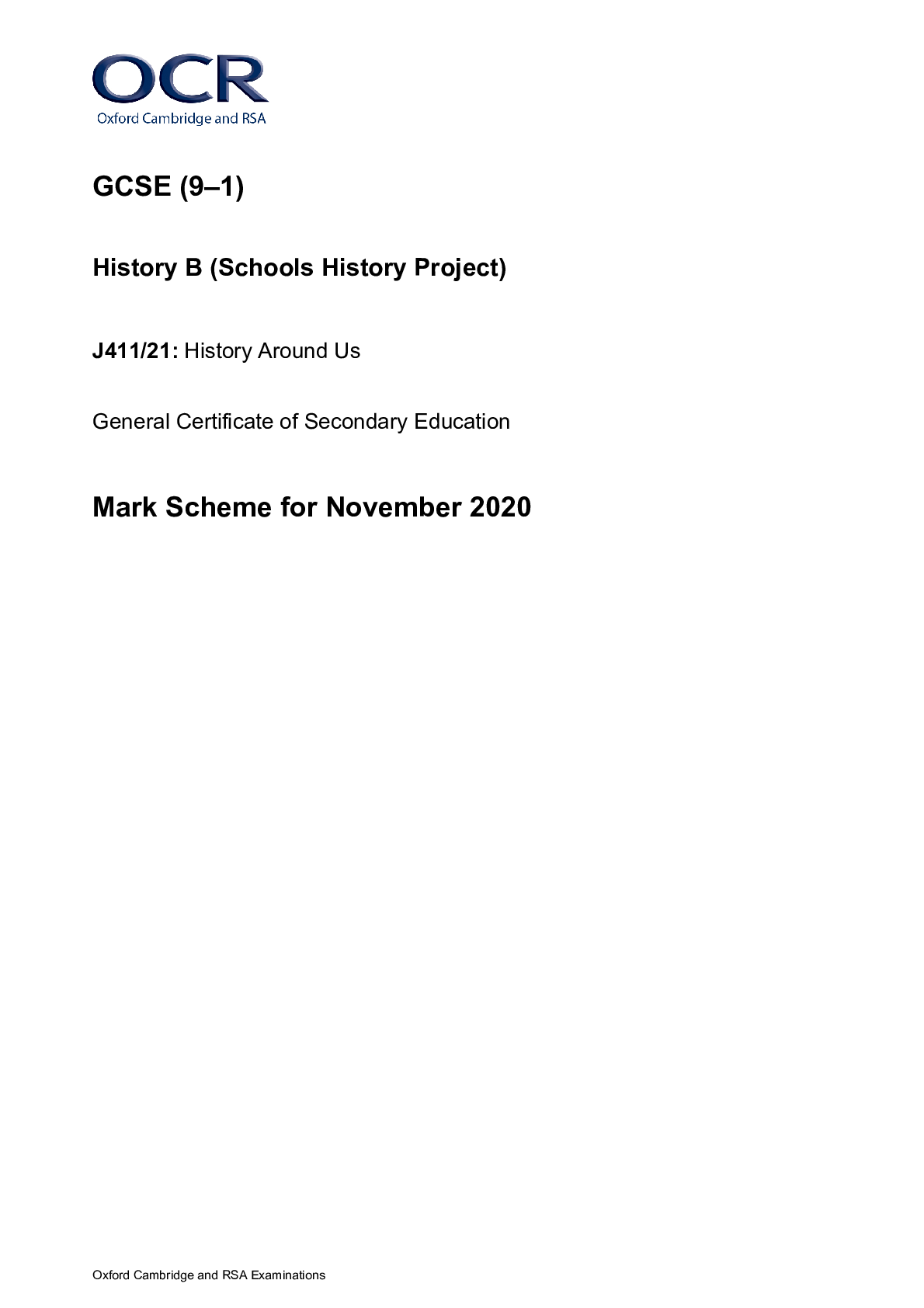
Buy this document to get the full access instantly
Instant Download Access after purchase
Add to cartInstant download
Reviews( 0 )
Document information
Connected school, study & course
About the document
Uploaded On
Oct 07, 2022
Number of pages
16
Written in
Additional information
This document has been written for:
Uploaded
Oct 07, 2022
Downloads
0
Views
45

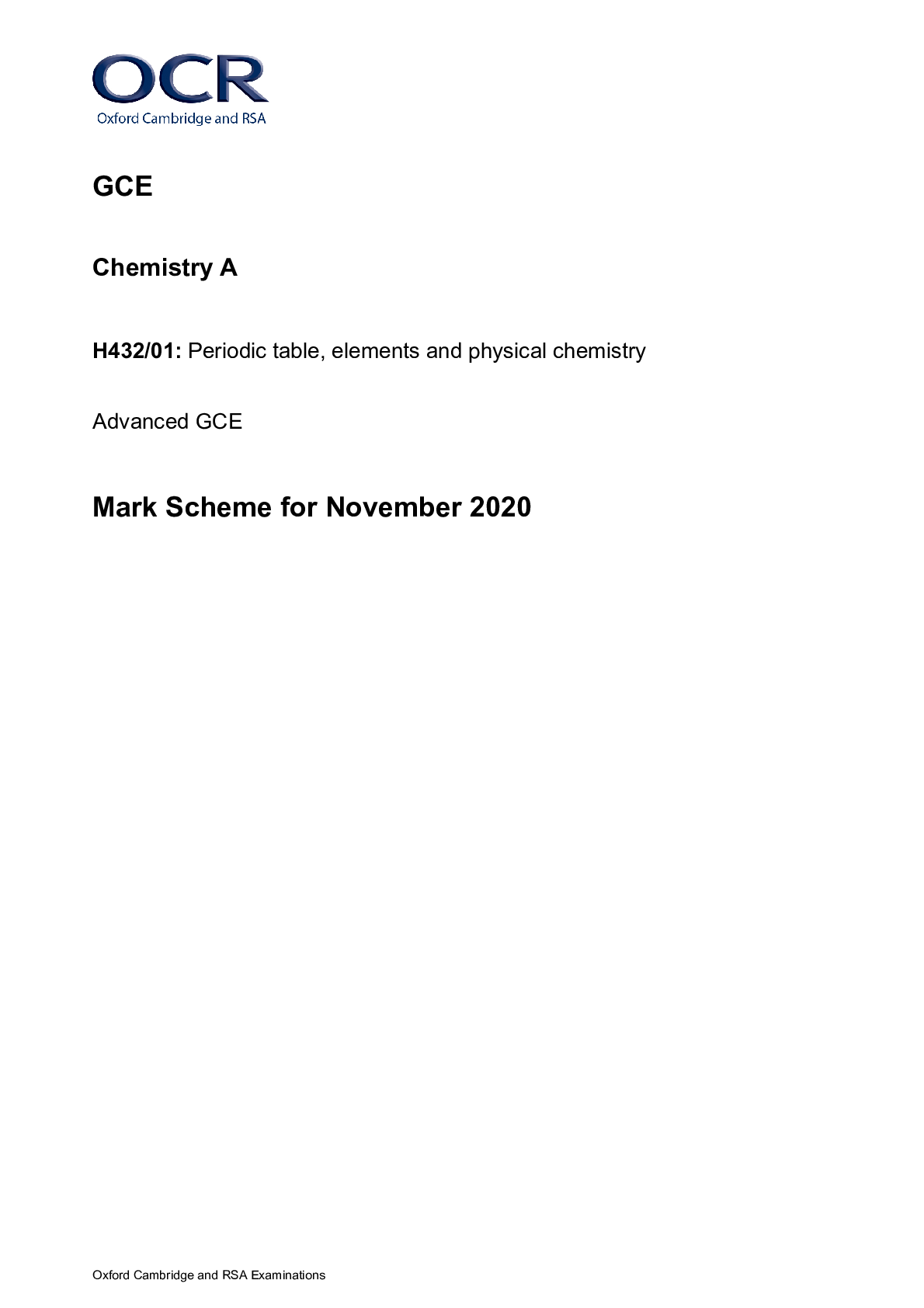

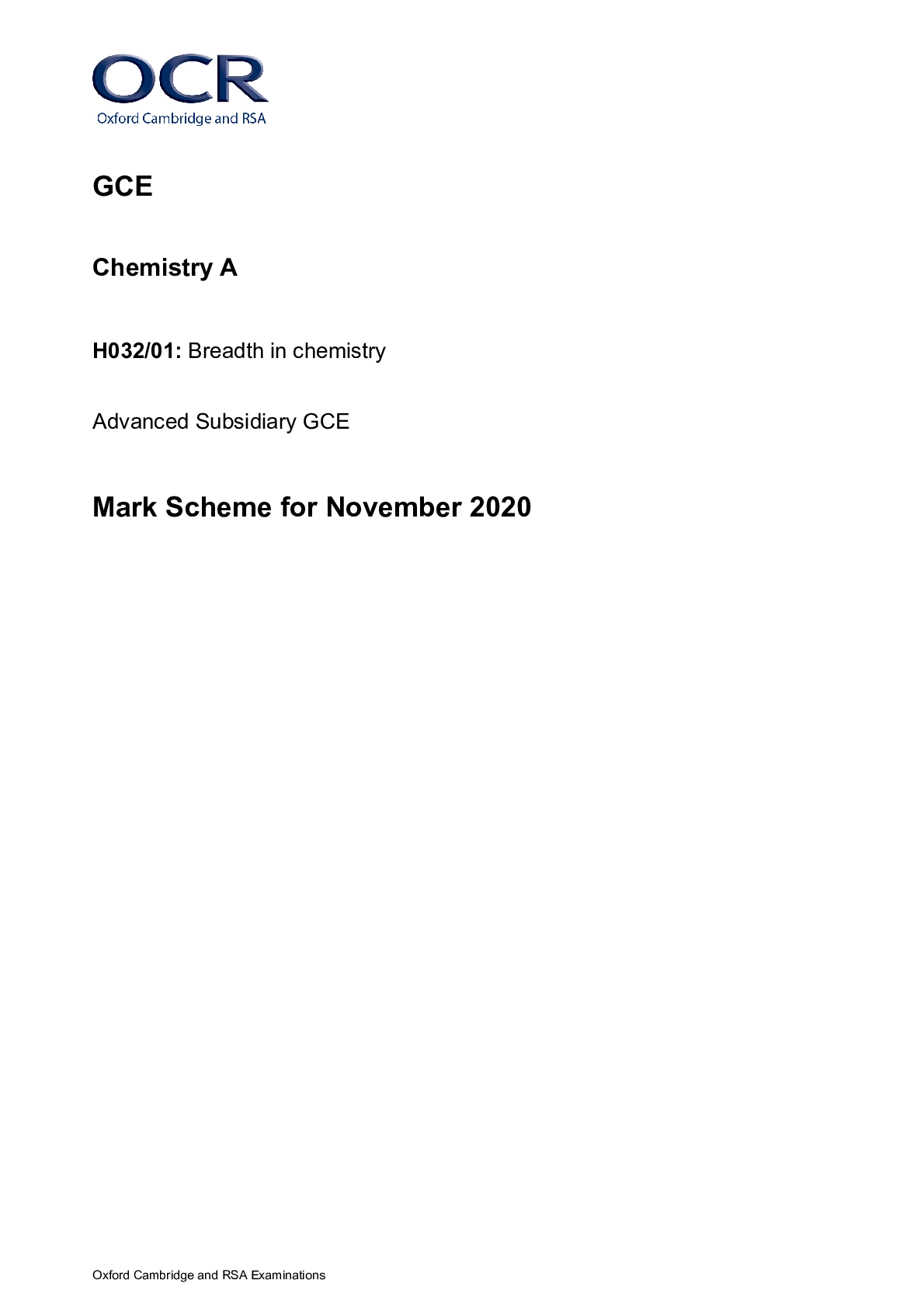


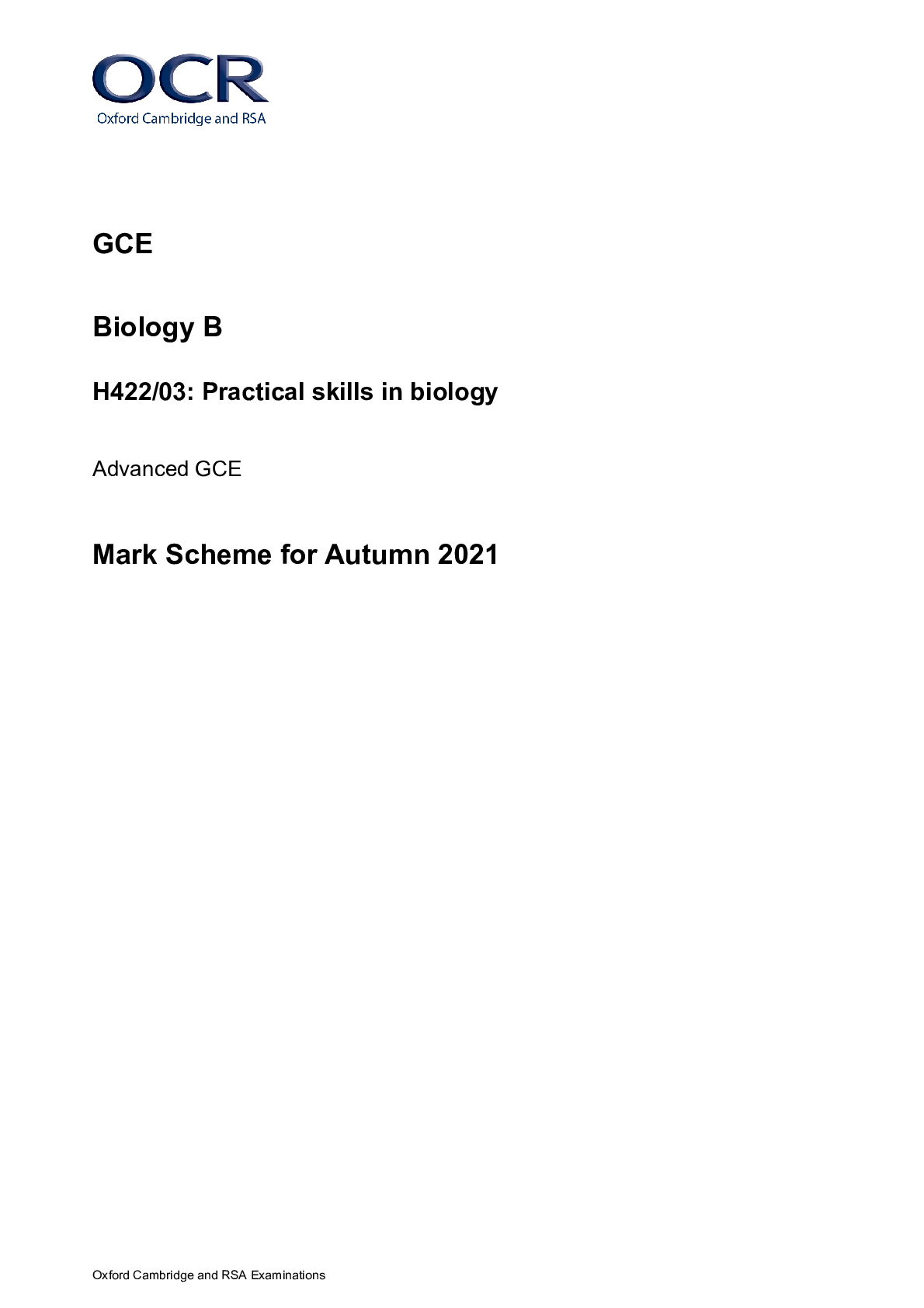

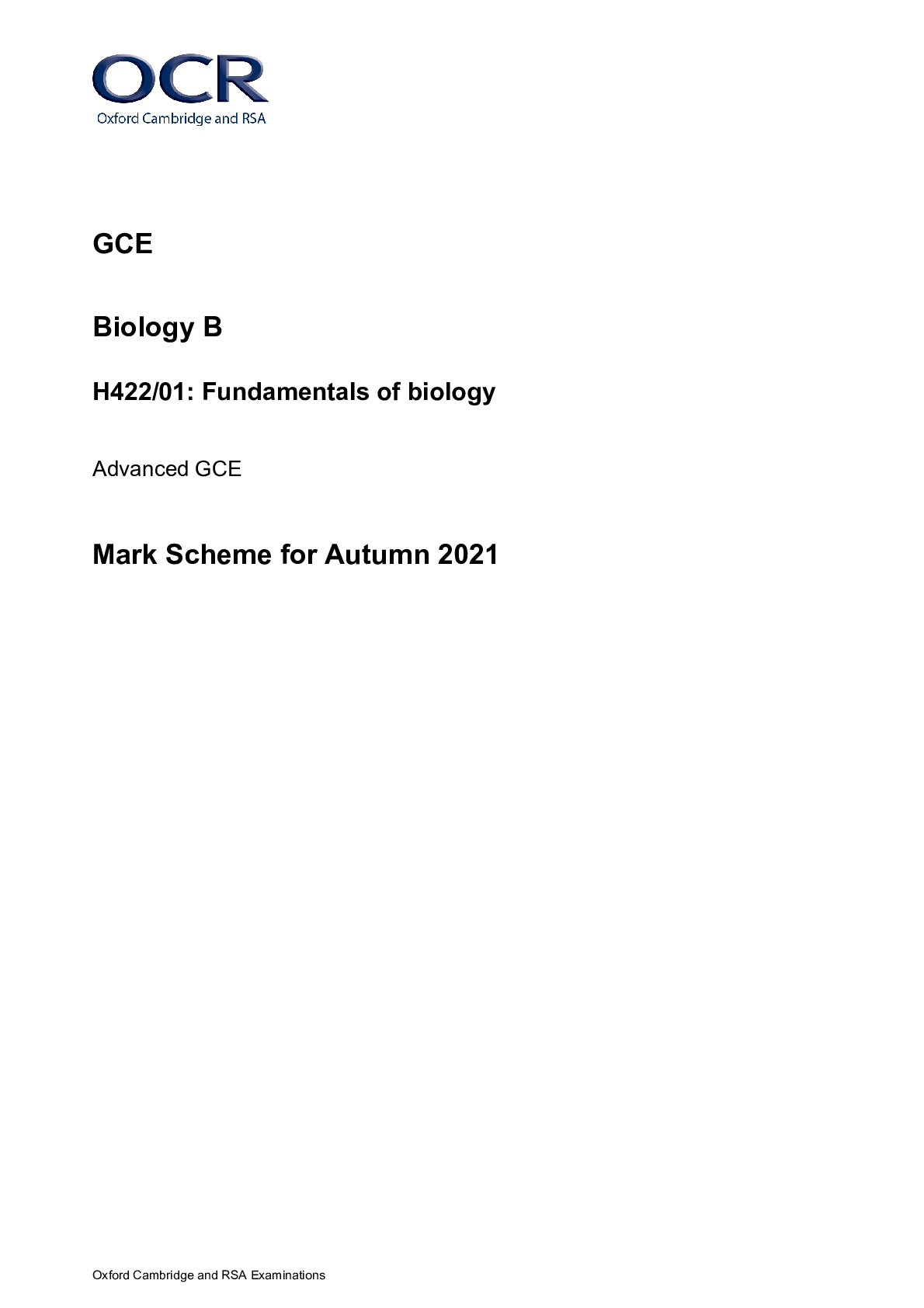
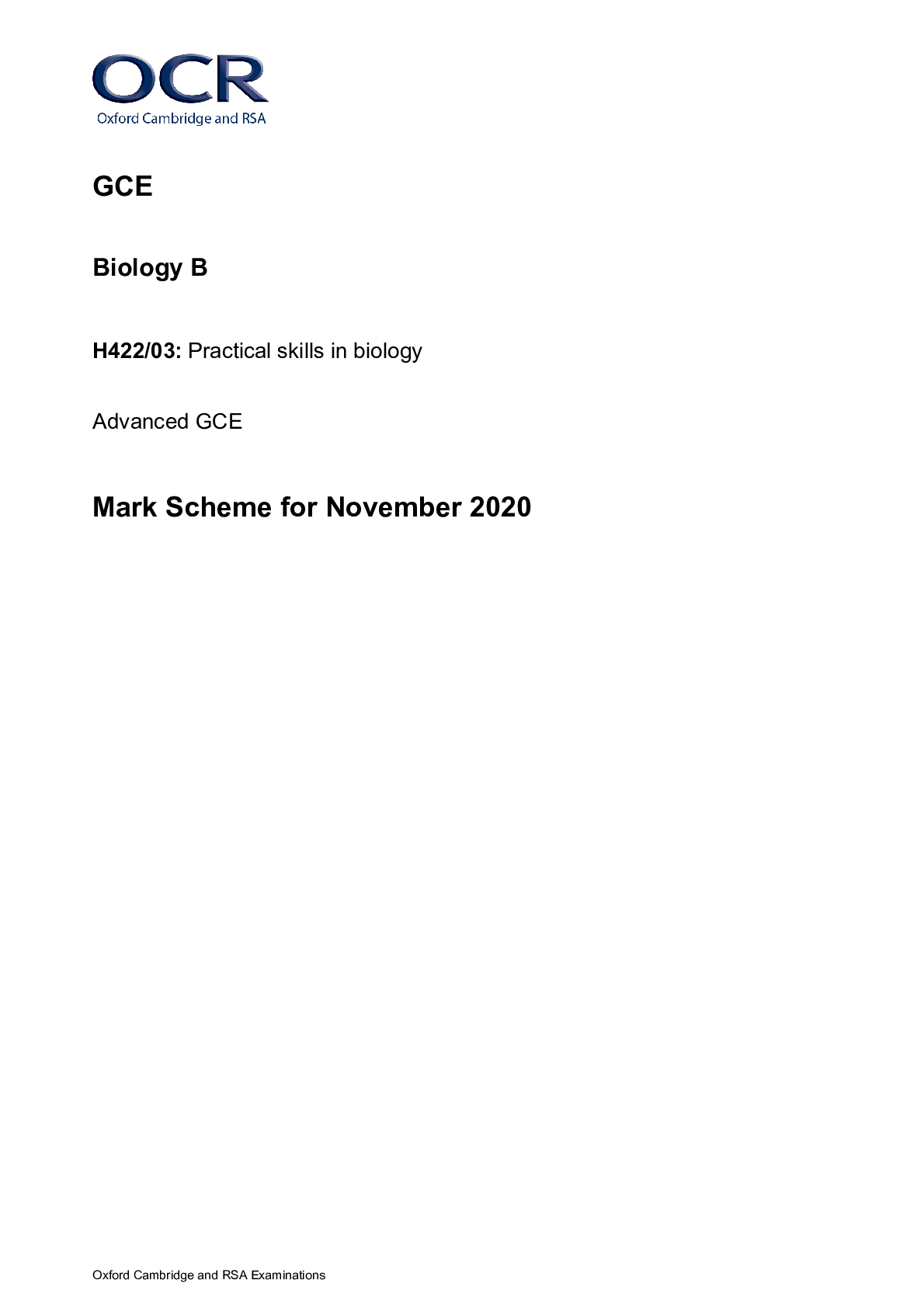
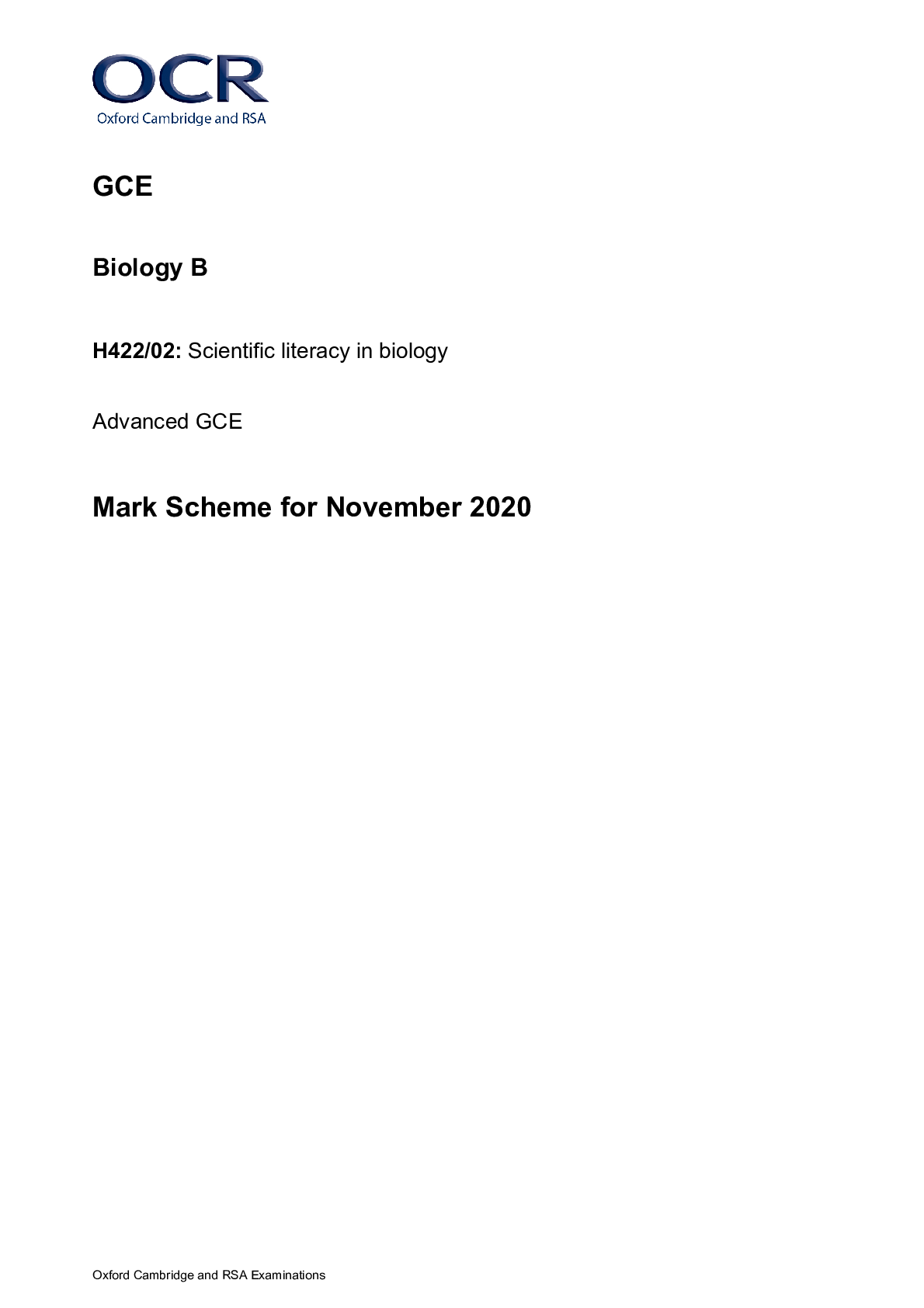
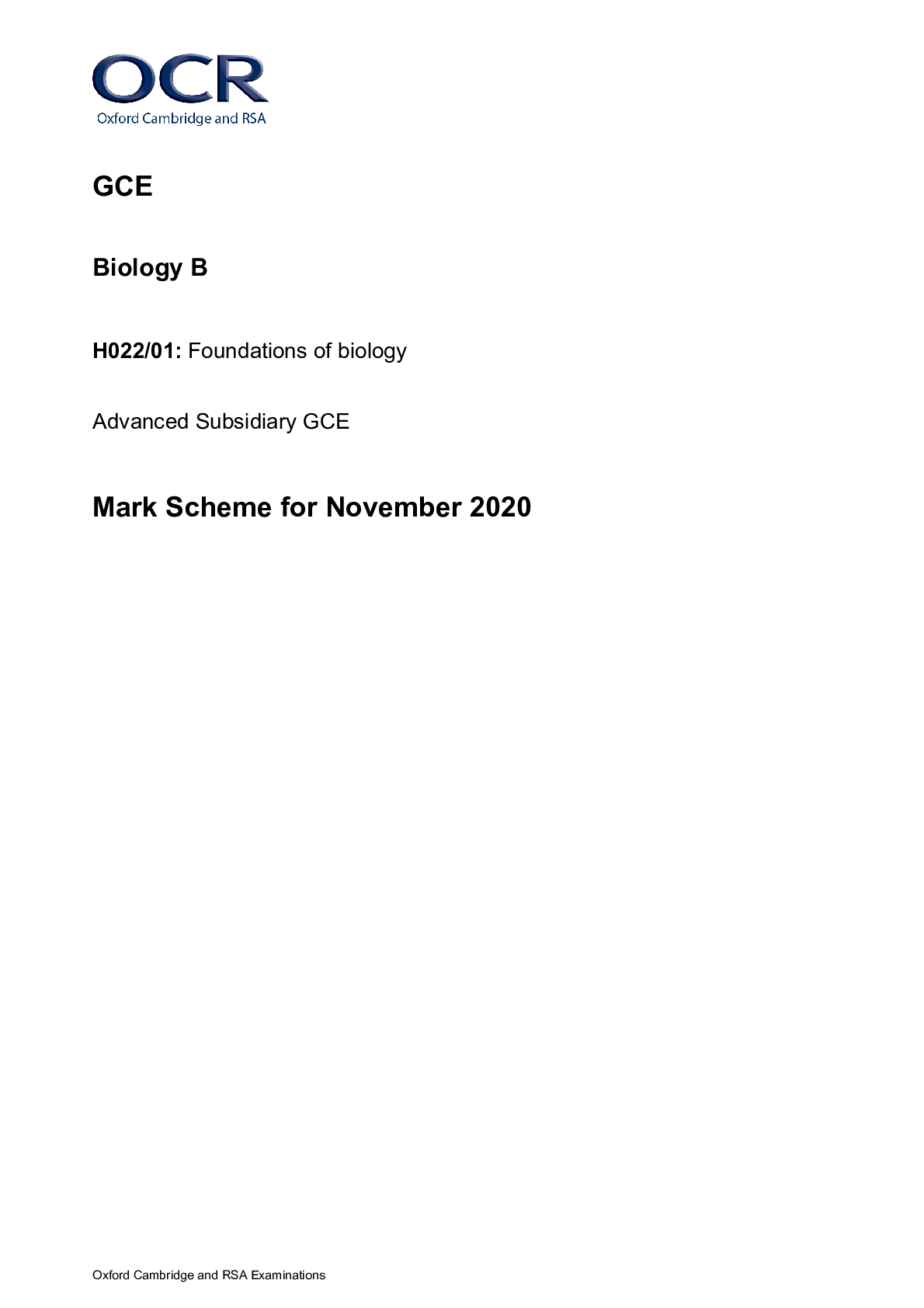



.png)
